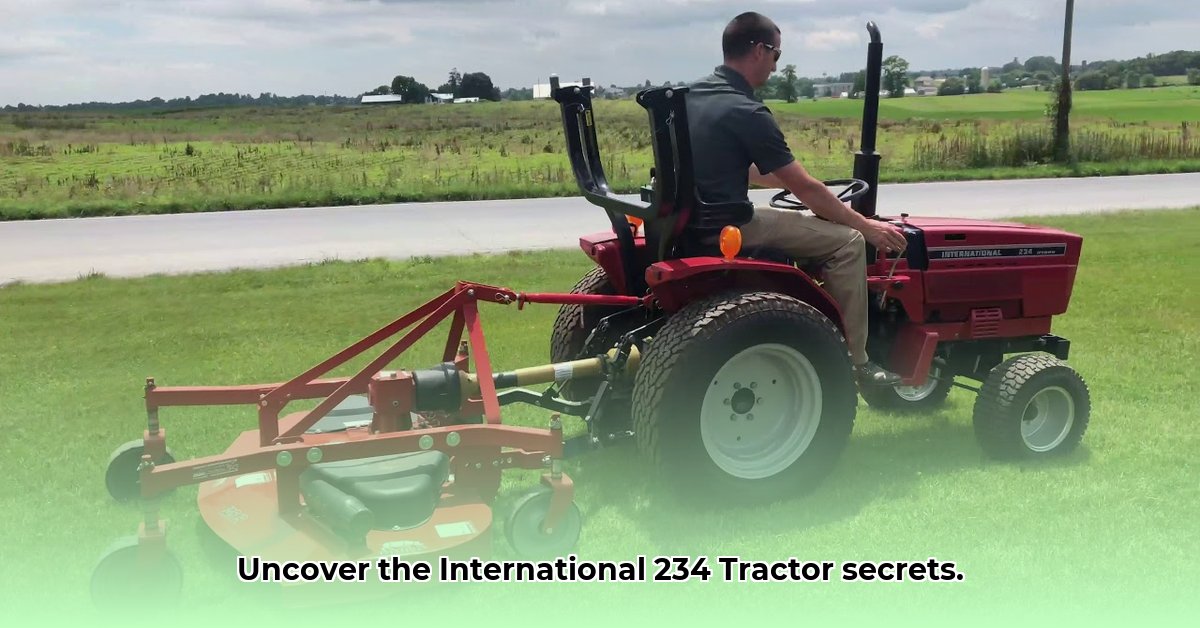
The International Harvester 234, a compact tractor produced between 1982 and 1984, represents a fascinating intersection of agricultural history and early 1980s technology. This guide delves into its origins, technical specifications, performance capabilities, maintenance challenges, and lasting legacy, appealing to both agricultural enthusiasts and history buffs. For more on larger IH tractors, see the information on this related model.
A Look Back: Agricultural Practices of the Early 1980s
The International 234 emerged during a transitional period in agriculture. While large-scale farming was gaining prominence, many smaller operations still thrived, requiring versatile and compact machinery. The 234 aimed to provide a cost-effective and efficient solution for these smaller farms, specializing in tasks requiring maneuverability rather than raw power. Its compact design was perfectly suited to orchards, vineyards, and smaller fields where larger tractors would struggle.
Under the Hood: Technical Specifications and Design
The International 234 featured a Mitsubishi-built, 0.8-liter three-cylinder diesel engine, delivering approximately 18 horsepower. This modest power output, however, was perfectly adequate for its intended applications. The transmission remains a point of some contention. While many sources cite a six-speed geared transmission with a possible hydrostatic option, others list six forward and two reverse gears. Further research is needed to definitively resolve this discrepancy. Similarly, precise PTO (Power Take-Off) specifications are elusive, highlighting the challenges of sourcing complete technical data for older machinery. The lack of readily available, comprehensive documentation for this model is a recurring theme for those seeking to restore or maintain these tractors.
Here's a summary of available specifications, noting areas of uncertainty:
| Specification | Reported Value(s) | Notes |
|---|---|---|
| Engine Type | 0.8L, 3-cylinder Diesel | Consistent across most sources. |
| Horsepower | ~18 hp | Approximate figure; precise output may vary slightly. |
| Transmission | 6-speed geared (with possible hydrostatic option) or 6 forward/2 reverse | Discrepancies exist in available documentation |
| PTO Power | Unspecified | Further research needed to determine specifications. |
| Dimensions | Unspecified | Exact dimensions are currently unavailable in accessible sources. |
This lack of detailed information emphasizes the challenges faced by restoration enthusiasts and agricultural historians alike in piecing together the full technical story of the International 234. This highlights both the complexity of archival research and the value of preserving historical documentation of agricultural machinery.
Performance and Capabilities: A Nimble Workhorse
Despite its modest power, the International 234 proved surprisingly versatile. Its compact size allowed for exceptional maneuverability, making it ideal for tasks requiring precision, such as cultivating smaller plots, working in orchards, or navigating tight spaces between rows of crops. While not equipped for the heaviest tasks of large-scale farming, it excelled in the niche it filled. Its simple design also contributed to its ease of operation and maintenance—at least, before the scarcity of parts became a major issue.
Comparative Analysis: Holding its Own
Comparing the International 234 to contemporary tractors reveals its strengths and weaknesses. While less powerful than some competitors, its compact design and maneuverability provided clear advantages in certain agricultural applications. This emphasizes a key point: tractor technology, like any other, is driven by specific needs and environments. The 234's effectiveness should be evaluated within the context of its intended applications – smaller farms and specialized tasks. A direct comparison with modern, compact tractors would reveal the considerable advancements in engine technology, hydraulic systems, and overall performance in the intervening decades.
Maintenance and Parts Availability: The Collector's Challenge
Maintaining and restoring an International 234 today presents a significant challenge: parts availability. The age of these tractors means original parts are scarce, expensive, or simply nonexistent. This scarcity drives up the difficulty and cost of restoration projects and is a major consideration for potential buyers. The limited availability necessitates resourcefulness, relying on online forums, specialized parts suppliers, and the informal network of International Harvester collectors and enthusiasts to locate replacements or fabricate needed components. This inherent challenge significantly contributes to its unique appeal among collectors. The restoration process becomes a testament to both mechanical skill and archival research.
Legacy and Impact: A Niche Icon
Despite its limited production run and the difficulty in accessing comprehensive technical data, the International 234 holds a special place in the hearts of collectors and agricultural history enthusiasts. It serves as a tangible reminder of the agricultural practices and technical capabilities of the early 1980s, reflecting the needs of a diverse farming community. Its continued presence, albeit in a niche market, speaks to its unique combination of dependability, maneuverability, and historical significance. Ongoing research and digital archiving initiatives among collectors and agricultural historians are crucial steps in preserving its legacy.
Conclusion: A Story of Function and Persistence
The International Harvester 234 tractor, though modest in power, played a significant—albeit understated—role in the agricultural landscape of the early 1980s. Its compact design, ease of operation, and suitability for smaller farms defined its niche. Its enduring appeal to collectors highlights the enduring connection between technology, history, and the human endeavor of agriculture. The challenges of restoration, stemming from parts availability and scarce documentation, make owning and maintaining one a rewarding, though often arduous, journey. This historical perspective underscores the importance of preservation efforts aimed at safeguarding both the physical machines and the knowledge surrounding them.